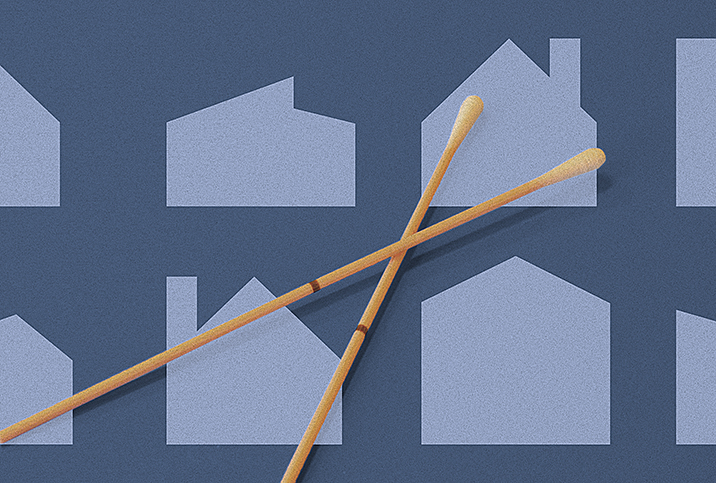A New Federal Initiative Aims to Distribute 1 Million Free HIV Tests

Americans may now test for HIV for free at home thanks to a new government initiative aimed at reducing the spread of the virus. This is especially good news because it's estimated there are 1.2 million people living with the human immunodeficiency virus in the United States, 13 percent of whom don't know they have it.
Anyone 17 or older who is living in the United States or Puerto Rico may order up to two free HIV self-tests every 90 days, according to a news release from the Centers for Disease Control and Prevention (CDC).
In a similar way to how some Americans ordered free COVID-19 tests from the government during the pandemic, people who order an HIV self-test through the CDC's Together TakeMeHome (TTMH) online portal will receive a discreet package in the mail including an at-home swab test.
The online ordering process takes two minutes or less to complete for people with access to a computer and the internet.
Ordering your free HIV test kit is easy
People interested in ordering a test must first provide basic information such as their first and last name, an email address, the number of requested tests and a mailing address.
Instructions on how to test for HIV at home are provided upon confirmation of your order.
"Take a deep breath and read the instructions in the kit," the TakeMeHome website reads, adding that there is a how-to video for anyone who is unsure of how to take a self-test.
The at-home HIV test contains a sterile swab you use on your gums, which you place in the provided test tube. The TakeMeHome website states that individual test results will be ready within approximately 20 minutes.
The CDC's goal is to distribute up to 1 million free HIV self-tests by 2028 with the help of partners Emory University, Building Healthy Online Communities (BHOC), NASTAD, Signal Group and OraSure Technologies.
Regardless of health insurance or immigration status, anyone age 17 or older can order free HIV tests through the program, according to the CDC.
"HIV testing is a critical HIV prevention strategy and a key first step in the continuum of HIV care, yet too many people are unaware of their HIV status," said Robyn Neblett Fanfair, M.D., M.P.H., acting CDC division director of HIV prevention, in the news release. "By offering free HIV self-tests through mail delivery, TTMH addresses common barriers to HIV testing, such as stigma, privacy concerns, cost and lack of access to HIV clinics, giving people who otherwise might not have tested an opportunity to know their status."
More than 30,600 Americans were newly diagnosed with HIV in 2020, according to CDC data.
Between 2016 and 2019, the CDC estimated the annual number of new HIV diagnoses decreased by 8 percent.
What is HIV?
Once considered a death sentence in the 1980s and '90s, today, Americans with HIV can live long, sexually healthy and active lives.
Human immunodeficiency virus is the viral precursor to acquired immunodeficiency syndrome (AIDS), its more advanced and deadly manifestation. When an HIV infection is spread through blood, semen or vaginal fluids, the virus attacks its host by damaging the immune system, inhibiting a person's ability to fight off other infections.
If left untreated, HIV can lead to AIDS.
In the years since the first AIDS case was reported and diagnosed in 1981, more than 700,000 Americans have died from HIV-related illness, according to the Kaiser Family Foundation, a nonprofit health policy organization.
While a cure for HIV/AIDS has yet to be found, treatments exist to keep HIV infections from becoming AIDS. The CDC states "most people with HIV" in the U.S. do not develop AIDS because prescription HIV medication is effective in halting the progression of the disease.
Medication can enable HIV-infected individuals to achieve and maintain an undetectable viral load, meaning the virus is at such low levels it is undetectable in their bloodstream. They are then unable to transmit HIV to their sexual partner.
Common cold or HIV?
Two to four weeks after being infected with HIV, a person may experience flu-like symptoms including dizziness, nausea or headaches. Typical HIV symptoms can easily be overlooked and dismissed as the common cold.
Difficulty sleeping, exhaustion, fever and chills may accompany a possible HIV infection, with less common symptoms being eye pressure or pain, or swelling of the lymph nodes and throat.
Florida, Texas and California have the highest rates of new HIV infections in the country, with most new infections—80 percent—originating in major U.S. metropolitan areas, according to a report published in 2021 by the Kaiser Family Foundation.
How to order your free HIV test kit
- Go to https://together.takemehome.org/.
- Read the important information on the page about how to take the test and how the privacy policy protects you and your identity.
- Click the "Order Now" link on the page.
- In simple steps, you'll be led through the completion of the personal information required to mail your test, and that's it.
You may order up to two free HIV tests every 90 days.


















